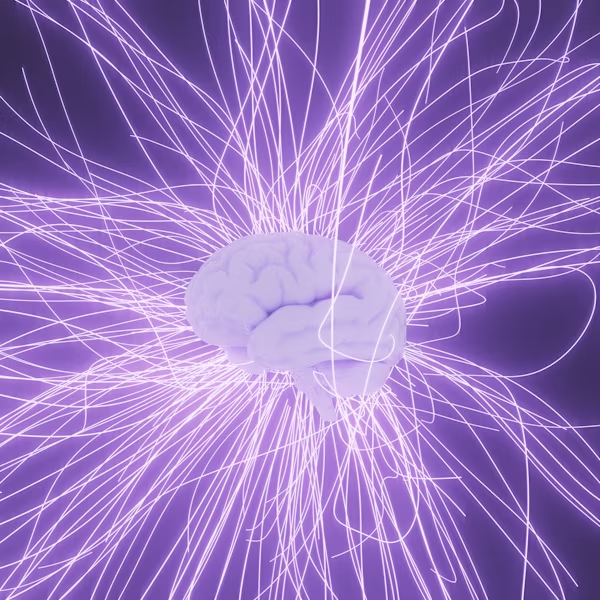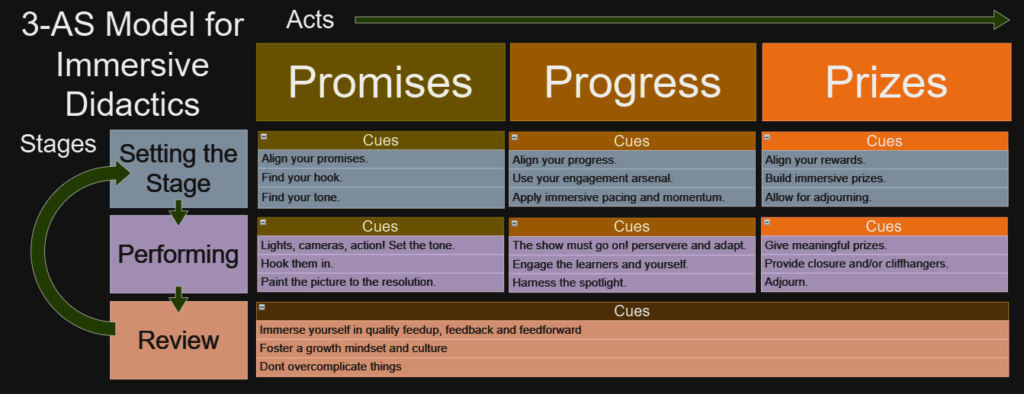Immersive Didactics is a didactical approach that strives to achieve a cognitive state we call Immersion in learners. Everybody recognizes this cognitive state intuitively. When you ‘wake up’ from being thoroughly engrossed in a book, a movie or a video game and wonder where the time’s gone, you’ve been immersed. Being immersed can be quite nice: a pleasurable subjective experience. People zooming into their smartphone for hours on end only to wake up later often do so because they like playing candy crush. The emotional resonance with the story you feel during the Disney classic ‘The Lion King’ also pulls you into the story, only for you to wake up after 1.5 hours wondering where the time has gone. Luckily, as it turns out, Immersion can also be very effective for educational purposes. A movie that really grabs you is a movie you often remember well and fondly. Another intuitive example of immersion is found in diving; people often report that when they submerge, they feel immersed in a whole new world, lose track of time and vividly remember their experiences in this totally engrossing experience of underwater life.
This state of Immersion has been widely studied in the fields of education, neurology and entertainment. In these fields, this state we dub Immersion has been solidly linked to better ‘learning results’, such as long time retrieval of information, deepened understanding of the material, a sense of well being during the experience and a proclivity of people to want to return for more of the experience.
Picture by Shino Nakamura via unsplash.com

Now let’s take a look and lay down some fundamentals of what we consider Immersive Didactics and how this helps learning. First, we must take a look at what Learning itself entails through the lens of Immersive Didactics. Luckily, we’ve got a definition.
“Learning is the act of acquiring and strengthening neurological patterns that can be applied at a later time.”
Note that we use a very general definition of learning, and that we look at learning as a physical process that involves the biological reality of neurology and falsifiable neurological patterns. Thus, we take a very ‘brain centric’ approach to understanding learning, for better or worse. We intentionally stay away from metaphysical concepts that muddy the waters in understanding learning. For Immersive Didactics all ‘knowledge’, ‘skills’, ‘attitudes’ and other popular terms normally associated with learning are rooted firmly in physical reality; they are neurological patterns in our minds that are first acquired and then have to potential to be applied at a later date. We try to only deviate to metaphysics when regular old falsifiable physics can not help us anymore. The ‘later time’ in the definition can both be short term learning and long term learning. At Immersive Didactics we assume that long term learning is facilitated when the neurological patterns of said learning are further engraved into our brains. In a sense, long term learning occurs when the neurological pattern is strengthened, thus increasing it’s applicability at a later time.
Also, note that per our own definition Immersion isn’t necessary for learning to occur. We only posit that Immersion is beneficial for learning. As such, you can look at Immersive Didactics as a way to optimize the process of learning, an intuitive and interdisciplinary lens with which to explain ‘learning’ as an understandable and reproducible story and mental model. Not an end-all be all, yet, a powerful perspective.
Picture by George C via Unsplash.com

The Immersive Didactics Model of Learning
Please note that Immersive Didactics isn’t purely rooted in neuroscience. Learning, even to our limited brain-centric definition is fairly complex and cannot (yet) be studied wholly by measuring our physical reality. The best we can do for our theory of learning is to craft an actionable and evidence-informed story about the underlying mechanisms of Learning to the best of our ability that educators can benefit from. To that end, we needed to integrate insights from other fields of study such as psychology, evolutionary biology, educational science and many others into a story that is internally consistent, understandable and actionable. To fit this purpose, we developed a theoretical model titled The Cognitive Cycle of Immersive Education. This model basically functions as a feedback loop The main underlying models to this cyclical model of learning are: (1) Global Workspace Theory, a neuroscience theory about consciousness and information processing in our brains, and (2) Integrated Information Theory, which is a more math-heavy approach to information processing and consciousness. We combine these theories of human consciousness with empirically found relationships between hormonal secretions, emotions and learning effects. If you want to make a deeper dive into this topic, please consult our article The Cognitive Cycle of Immersive Education.
Now let’s zoom back into Immersion and how to achieve this cognitive state.
Immersion
At Immersive Didactics, we define the cognitive state of Immersion as:
“Immersion is a cognitive state in which the learner allocates seemingly all their cognitive resources towards the learning experience, fully engrossing themselves in the learning experience and losing track of time.”
So now you may wonder: How does Immersion occur?
“The cognitive state of Immersion occurs when sufficient Engagement with the learning material is sustained over a sufficient amount of time.”
Notice that we do not define what ‘sufficient Engagement’ is, nor what ‘sufficient Time’ embodies. We cannot do so as this differs per learner and the context in which they learn.
Essentially, we define Immersion as sustained Engagement to the point of losing track of time and other concerns. Furthermore, we posit that Immersion will make students want to re-engage with the learning materials. Essentially, this boils down to Immersive Didactics wanting to achieve a feedback loop of sustained pleasurable Engagement with the learning experience that leads to Immersion, and thus re-Engagement. We use a very simple and straightforward cyclical model to reach and sustain this cognitive state of Immersion that we call The Cognitive Cycle of Immersive Education. It is defined as follows:
“When sustained Engagement over time leads to the cognitive state of Immersion, and this Immersion is subjectively experienced by the learner as pleasurable, the learner may be more prone to seek out future sustained Engagement with the learner experience for a sufficient amount of time to become Immersed again.“
Note that in this formula, we do not define what is sufficient engagement or sufficient consecutive time to reach the state of immersion. Also, we do not define what Pleasurable Immersion is. We do not define these things because they will be wildly different in individuals and contexts. People have different tolerances and needs for cognitive and sensory arousal and as such different needs with regards to learning content. What remains though, is that they all benefit from Immersion through sustained Engagement. To illustrate this, let’s look into two examples of perfectly valid and Engaging learning content. Afterwards, we’ll zoom into Engagement and how this can be fostered.

Imagine blaring sirens, loud dogs barking, heat all over your body, tired arms and legs from standing in your riot gear all day, and then being screamed at, charged and physically assaulted by a group of angry drunk men with folding chairs and baseball bats.
This example may be perfectly Immersive educational content if this was riot training for a police force somewhere. The officers in training (as well as the hired rioters, I may add) may actually like this. They may love the adrenaline, physical discomfort and overstimulated senses, as long as it makes them better at their job. They may love it so much indeed, that next year they want to do it again. They might sign up for the riot squad. Others may develop a strong dislike of riots, fire and screaming bald men, opting for a nice and comfy desk job in the police force.

Now imagine silence, only broken by the low whir of machinery and other students sighing, a table in front of you with 30 vials of colorful chemicals, and the strain of remembering which one to add to which in which order and to what extent. Being absolutely precise is important, in both the physical aspects of your task as well as your meticulous calculations and reporting.
This may also be perfectly Immersive educational content if it was a lab practical for a biochemistry university course. The students may actually like the silence, the feel of the rubber gloves, the hard cognitive puzzle and the need to work and report precisely according to very rigid standards. The student may find out they love working in a laboratory setting and seek out other courses with lab skills or pursue careers which involves working in the lab, looking to be immersed again. Others may think that this lab situation is all fine and dandee, but biochemistry money is to be found in medicine development, so they opt for different courses and career paths.
What makes Learning pleasurable?
We’ve posited before that learners who have pleasurable Immersive learning experiences are more likely to seek out such experiences again. Also, we described that humans differ in their subjective experience of pleasure. Police officers in the riot squad probably have a different average stress tolerance and find pleasure in different things than biochemistry majors. What all human beings on the planet regardless of individual preferences share however, is general brain anatomy and chemistry. Put simply, the release of pleasurable hormones in the brain make us all feel good. The triggers that release these hormones differ wildly in people and both nature and nurture band together to shape our wildly different subjective experiences when confronted with different stimuli. At Immersive Didactics, we seek to make clever use of the science of these neurotransmitters and how they can make Learning more effective. We’ve integrated our knowledge of these neurochemicals (and more) into Immersive Didactics, for instance in the design of flexible The 3-AS Model for Immersive Education. If you want more information about the neuroscience of learning, please consult our article The Cognitive Cycle of Immersive Education.
How does Immersion work?
We define Engagement as such:
“Engagement is that which pulls a learner into the learning experience.”
There are many things that pull learner into a learning experience, and all of them start with a stimulus. For simplicity sake, we divide stimuli into two distinct categories; sensory stimuli and cognitive stimuli. Both types of stimuli trigger processes in our brain that shape our subjective experiences and behavior. As such, all engagement follows from stimuli.
Image by Vidar Nordli-Mathisen via Unsplash.com
“All Engagement follows from stimuli.”

An example of sensory stimuli that allows for learning may be the sudden intense sensory experience of heat and pain when a boy holds his hand over a flame. The sensory mechanisms in the boys body register the heat, transporting electrical signals from special sensory nervous cells to the boys brain, prompting the child to reflexively retract his hand. Afterward, pain is experienced, and thus a negative physical and emotional experience are linked to holding a hand over a flame too closely. The boy engraves a new pattern in his mind for future reference: flames are hot, painfull, bad.
Image by Yaoqi via Unsplash.com

An example of a cognitive stimuli might be the grandmother of the girl providing solace by speaking kind words to her. The girls ears pick up the sounds and kind facial expressions of the grandmother, converting them into electrical signals, which are interpreted in a specialized language region in the brain. The child learns from her grandmother that although she experiences pain now, it will pass, and she will be fine. The girl learns to recognize the pattern that her grandmother is there to help, and that although she sometimes makes mistakes, she can find safety.
Image by Ekaterina Shakharova via Unsplash.com

Sometimes, or indeed for some people very often, random thoughts enter our brains seemingly entirely unprompted by sensory experience. A sudden idea about a work project, or a negative self reflection about something that should’ve been said or done. These unprovoked ‘random’ thoughts can be highly Immersive, illiciting strong emotional and physical reactions, prompting us to learn. This can go both ways, positive and negative. A person who constantly bombards themselves with negative self talk may indeed develop an intensely negative subjective experience. Thoughts in that regard, may start to form ingrained patters in people’s subjective experience. Likewise, a person who is constantly kind with themselves may develop learned patterns of resilience and positivity. A student who constantly daydreams of becoming a great lawyer, practicing arguments solely in their mind and reflecting upon these arguments, may become a great lawyer. The patterns of law and argument may become more and more engrained in their cognition. Likewise, a person learning Spanish who constantly thinks about the language and practices phrases they memorized in their head probably learns Spanish quicker and to a better proficiency than someone who doesn’t. The patterns of Spanish diction and vocabulary become more and more apparent to them. Thus, our subjective cognitive experience that is not (directly) provoked by sensory stimuli shapes the impact we have on our world to a large extent. Different people experience different levels of Immersion with their thoughts, but is generally agreed in modern psychology that being mindful and practicing mindfulness with regards to these thought patterns can help people manage them and have more pleasurable subjective experiences. This is called meta-cognition, a fancy term for the cognition of being cognitive.
Image by Samuel Austin via Unsplash.com

Ultimately, psychologists, neurologists and philosophers are on the fence if any thought can be truly unprovoked by sensory stimuli. Determinists may argue that whatever happens happens because of physics and all that is could be predicted in advance without any truely spontanious thought, free will or volition anywhere ever. Thus, our construct of cognitive stimuli may only be belated sensory stimuli. Whatever perspective you choose, for the purposes of Immersive Didactics the result much the same. We posit that stimuli may be Engaging and ultimately lead to Immersion, and the distinctions are only there to help shape our understanding of Learning in an intuitive manner.
Now that we looked at how Sensory and Cognitive Stimuli drive Engagement and can thus facilitate Learning, we can zoom out a bit and ask ourselves the question: how can we cleverly use stimuli to drive up Engagement?
Remember, Engagement in Immersive Didactics is ‘That which pulls the learner into the learning experience.” As such, there are many stimuli that may be wildly stimulating, bot not necessarily Engaging with the learning experience. In other words, overdoing it with stimuli that detract from the learning experience at hand may work wonders to distract learners. These stimuli that distract from the learning experience we call ‘Disengaging stimuli.’ Furthermore, a stimulus that may be considered Engaging in isolation may be Disengaging in conjunction with other stimuli, because Sensory Overload may occur. We all know PowerPoint presentations with way too many animations, sound effects and buckets of text splashed upon the screen.
The more learners are Engaged with the educational content, the more likely they are to become Immersed in the learning experience. The more people are Disengaged, the more likely they will not reach Immersion in the learning experience. As such, trying to stimulate Immersion with educational content entails cleverly using Engaging stimuli without ‘overdoing’ it. To practice Immersive Didactics, educators must strike a balance, like a chef layering seasoning into a meal or a builder who balances layer upon layer of stones to make a structure. Each meal and each built structure may require a different balance of seasonings or materials to provide for the needs of the guest or the client, yet underneath, the same balancing principles are at play. As such, a teacher may have a different classes with different needs and different students with different needs for their educational experiences. The balance can never be perfect, but we can try.
To help educational professionals make informed decisions on balancing these Engaging Stimuli for their educational content, Immersive Didactics follows the evidence informed principles from the Cognitive Theory of Multimedia Learning and many other empirically tested theories in the broad field of educational science.
Image by Patrick Fore via Unsplash.com

Notice also, that all the examples we gave thus far have been about relatively short-term learning experiences without complex contexts. When the amount of time and the complexity of the learning content increases, we posit that educational professionals need more guidance on how to keep learners engaged and ultimately immersed with educational content. To that end, The 3-AS Model for Immersive Didactics was developed. This model is filled with clever interdisciplinary tricks to keep learners engaged with the educational content to ultimately immerse them no matter the scope of the educational content. Below, we introduce how this model can help us make our education more Immersive.
How can we make learning more Immersive?
Let’s try and apply what we learned about The Cyle of Immersive Education and the underlying Engagement and Stimuli to education. As we mentioned before, Engagement can readily lead to Immersion on the short term and in relatively simple contexts. Yet, as the demand on the educational content increases in time and complexity, more clever design is needed.
To that end, we’ve developed The 3-AS Model for Immersive Didactics. This model is made to help educators Immerse learners into educational content by leveraging our clever understanding of how Learning works; Engaging the learners with the educational content to such an extent consecutively that Immersion may occur. First let’s define what we mean by Educational Content.
“Educational Content is the collection of educational products and processes that are supposed to facilitate the process of Learning.”
Note that this is a very broad definition. As such, Educational Content can take the form of a curriculum guide, a study book, a video, a lesson, a study mentoring talk and much more. The beauty of 3-AS Model for Immersive Education is that it allows educational professionals to use the same basic heuristics and mental models on a wide variety of different contexts.
If you want to apply The 3-AS Model for Immersive Didactics, or learn more about it, please click here.

What theory and practice were integrated in this article?
Cognitive Load Theory: Sweller
Cognitive Theory of Multimedia Learning: Clark & Mayer
Global Workspace Theory: Baars et. al.
Information Integration Therapy: Anderson et. al.
Cognitive Behavioral Therapy and Mindfulness practice: various authors
Various educational science models.